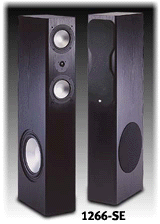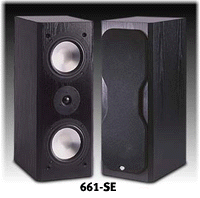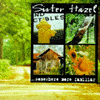This article appeared online September 2001, AudioRevolution.com
RBH Sound Signature Series 5.1 Speaker System
By Richard Elen
Introduction
 When
purchasing your audio/video system, there is no component that better
defines its character than your speaker system. Speakers define both the
sonic and aesthetic personality of your sound system. With the better
part of the audiophile era behind us, a time when a good-sounding
product in a hideous package seemed acceptable, the importance of
combining performance with an attractive look has never been greater.
When
purchasing your audio/video system, there is no component that better
defines its character than your speaker system. Speakers define both the
sonic and aesthetic personality of your sound system. With the better
part of the audiophile era behind us, a time when a good-sounding
product in a hideous package seemed acceptable, the importance of
combining performance with an attractive look has never been greater.
 Several
months back, I approached RBH about reviewing their loudspeaker
systems. RBH is hardly a newcomer to the audio/video industry having
just celebrated their 25th anniversary. Having seen and heard their
speakers at CES 2001, I was intrigued with their products, as they
appeared to perform very well in an environment that is less than
optimal, and because their speakers looked to be well-built at an
affordable price. Finding products of value is a high priority for
AudioRevolution.com. After speaking with RBH, we selected a speaker
system that was felt to best match the size of my A/V room. Having an
appetite for performance, I selected a 5.1 package from RBH’s Signature
Series line.
Several
months back, I approached RBH about reviewing their loudspeaker
systems. RBH is hardly a newcomer to the audio/video industry having
just celebrated their 25th anniversary. Having seen and heard their
speakers at CES 2001, I was intrigued with their products, as they
appeared to perform very well in an environment that is less than
optimal, and because their speakers looked to be well-built at an
affordable price. Finding products of value is a high priority for
AudioRevolution.com. After speaking with RBH, we selected a speaker
system that was felt to best match the size of my A/V room. Having an
appetite for performance, I selected a 5.1 package from RBH’s Signature
Series line.
For front main loudspeakers, I used the Signature 1266-SEs, the highest-performing speakers in the Signature line. The 1266-SE is a tall, slender speaker, measuring 48 inches in height, eight-and-three-quarters inches wide, 16 inches deep and weighing 79 lbs. The rear-ported design has a driver complement of two six-and-one-half-inch aluminum midrange drivers, a single one-inch silk dome tweeter, and a side-firing 12-inch aluminum woofer. The 1266-SE has a rated frequency response of 27Hz to 20kHz at +/- 3dB, with a rated sensitivity of 88dB. These loudspeakers retail for $2,600 per pair in standard black finish, and $3,400 in any of the 30 available veneer veneer trims.
 For
the center channel speaker, I used the 661-SE, also from the Signature
line, which can be used in pairs as mains. This single speaker measures
22 inches wide while lying on its side, eight-and-three-quarters inches
tall, and 11.25 inches deep. Its driver complement is a single one-inch
silk dome tweeter, with two six-and-one-half inch aluminum dome woofers
and an overall frequency range of 45Hz to 20kHz. The 661-SE also has a
ported design and weighs 31 lbs., retailing for $599 in standard black
finish or $759 in a vast array of custom veneer veneers.
For
the center channel speaker, I used the 661-SE, also from the Signature
line, which can be used in pairs as mains. This single speaker measures
22 inches wide while lying on its side, eight-and-three-quarters inches
tall, and 11.25 inches deep. Its driver complement is a single one-inch
silk dome tweeter, with two six-and-one-half inch aluminum dome woofers
and an overall frequency range of 45Hz to 20kHz. The 661-SE also has a
ported design and weighs 31 lbs., retailing for $599 in standard black
finish or $759 in a vast array of custom veneer veneers.
 For
surround speakers, I was provided with the Signature Series 61-SE
loudspeakers. This is another speaker in the Signature line that can be
used in pairs as front mains. However, in this case, they made for a
recommended match to the selected front main and center channel
speakers. The 61-SEs are somewhat diminutive in size, yet they provide
sizable low-frequency performance. The 61-SE measures 14.5 inches tall,
eight-and-three-quarters-inches wide and 11.25 inches deep. The 61-SEs
use a one-inch silk dome tweeter and a 6.5-inch aluminum dome woofer.
The 61-SE weighs a mere 22 pounds and has a rated performance of 45Hz to
20kHz. The retail price of the 61-SE is $900 per pair in standard
finish or $1,100 per pair in custom veneer.
For
surround speakers, I was provided with the Signature Series 61-SE
loudspeakers. This is another speaker in the Signature line that can be
used in pairs as front mains. However, in this case, they made for a
recommended match to the selected front main and center channel
speakers. The 61-SEs are somewhat diminutive in size, yet they provide
sizable low-frequency performance. The 61-SE measures 14.5 inches tall,
eight-and-three-quarters-inches wide and 11.25 inches deep. The 61-SEs
use a one-inch silk dome tweeter and a 6.5-inch aluminum dome woofer.
The 61-SE weighs a mere 22 pounds and has a rated performance of 45Hz to
20kHz. The retail price of the 61-SE is $900 per pair in standard
finish or $1,100 per pair in custom veneer.
 The
subwoofer that was selected was the impressive-looking 12-SE, which was
stunning to look at with its veneer veneer finish and radius edges. The
12-SE is 15-3/8 inches wide. 17 inches tall and 17.5 inches deep. The
12-SE is a vented-enclosure, powered subwoofer with an internal 300-watt
amplifier. Its rated response drops down to 30Hz at +/- 3 dB which,
although isn’t among the lowest-rated frequencies on the market, is
still fairly low. However, it’s the in-room performance of a subwoofer
that is important. As your room interacts with and contributes to your
sub’s performance, this db number proves to be much less significant
that a real-life testing in your listening environment. The 12-SE
provides volume control, adjustable low-frequency cutoff, and a
180-degree phase inversion switch, providing assistance so that you can
properly match the phase based on the position of your sub relative to
the position of your other supporting speakers. Additionally, the 12-SE
has a low pass cutoff switch for applications in which you are
controlling the LFE from your electronics. It provides inputs and
outputs in both RCA and speaker binding posts, which will accept a
variety of speaker connections, including spades and banana plugs.
The
subwoofer that was selected was the impressive-looking 12-SE, which was
stunning to look at with its veneer veneer finish and radius edges. The
12-SE is 15-3/8 inches wide. 17 inches tall and 17.5 inches deep. The
12-SE is a vented-enclosure, powered subwoofer with an internal 300-watt
amplifier. Its rated response drops down to 30Hz at +/- 3 dB which,
although isn’t among the lowest-rated frequencies on the market, is
still fairly low. However, it’s the in-room performance of a subwoofer
that is important. As your room interacts with and contributes to your
sub’s performance, this db number proves to be much less significant
that a real-life testing in your listening environment. The 12-SE
provides volume control, adjustable low-frequency cutoff, and a
180-degree phase inversion switch, providing assistance so that you can
properly match the phase based on the position of your sub relative to
the position of your other supporting speakers. Additionally, the 12-SE
has a low pass cutoff switch for applications in which you are
controlling the LFE from your electronics. It provides inputs and
outputs in both RCA and speaker binding posts, which will accept a
variety of speaker connections, including spades and banana plugs.
The loudspeakers that were provided for me to review came in a very attractive walnut veneer veneer finish. RBH offers over 30 veneer finishes to choose from. Today it is quite rare to be offered choices of more than a few veneer trims. I found this feature notably attractive, as many of us are trying to visually integrate our loudspeakers into our fine homes. The RBH webpage listed below has a fully pictured list of almost all of the available veneer trims.
The Movies
 Initially,
I set the RBH speakers up in my living room theater system, rather than
my reference music and theater system. This is a system that is driven
by a high-quality theater receiver and is located in my living room.
After several weeks, I found myself so intrigued with the performance of
the 1266-SE front main loudspeakers that, one evening, I summoned a
neighbor to help me lug the entire speaker system into my dedicated A/V
room to give them the best possible environment and electronics to gauge
their performance. As always, I used a variety of tools to assure
proper set-up, such as an inexpensive SPL meter to set the appropriate
speaker volume and balance, and some calculations to gauge a starting
point for the necessary signal delays. Once I had the system set up, I
fired into a favorite animated feature, Toy Story 2 from The Ultimate
Toy Box 3 DVD set (Disney/Pixar). I would describe the overall sound of
the RBH 5.1 system as revealing, quick and energetic. The speakers were
not polite, yet didn’t sound fatiguing. In much of the dialogue in this
movie, I found the detail to be engaging. Getting more serious in
content, I slapped in a favorite drama, Good Will Hunting (Miramax). In
this relatively recent Oscar-winning film, there is a great deal of
dialogue that a system can resolve, absent of artificial effects such as
bomb detonations and car crashes. In Good Will Hunting, the RBH system
impressed me for several specific reasons. When the package had been
selected for me, I questioned whether the system would sound coherent,
due to the fact that the center speaker was a single speaker from a
pair, rather than a dedicated center. In fact, the center matched quite
well. When moving my head from side to side, trying to capture the point
where the center information began to blend with the mains, I found
that the information, although not exact, was very close in overall
tonality and flavor. I would refrain from comparing the RBH set-up to my
Revel Ultima Series theater, due to the overwhelming price difference,
but I will say that during the period that I had the RBHs in my
reference system, I didn’t feel that the level of enjoyment I was
experiencing from my movies was greatly diminished as compared to the
Revels.
Initially,
I set the RBH speakers up in my living room theater system, rather than
my reference music and theater system. This is a system that is driven
by a high-quality theater receiver and is located in my living room.
After several weeks, I found myself so intrigued with the performance of
the 1266-SE front main loudspeakers that, one evening, I summoned a
neighbor to help me lug the entire speaker system into my dedicated A/V
room to give them the best possible environment and electronics to gauge
their performance. As always, I used a variety of tools to assure
proper set-up, such as an inexpensive SPL meter to set the appropriate
speaker volume and balance, and some calculations to gauge a starting
point for the necessary signal delays. Once I had the system set up, I
fired into a favorite animated feature, Toy Story 2 from The Ultimate
Toy Box 3 DVD set (Disney/Pixar). I would describe the overall sound of
the RBH 5.1 system as revealing, quick and energetic. The speakers were
not polite, yet didn’t sound fatiguing. In much of the dialogue in this
movie, I found the detail to be engaging. Getting more serious in
content, I slapped in a favorite drama, Good Will Hunting (Miramax). In
this relatively recent Oscar-winning film, there is a great deal of
dialogue that a system can resolve, absent of artificial effects such as
bomb detonations and car crashes. In Good Will Hunting, the RBH system
impressed me for several specific reasons. When the package had been
selected for me, I questioned whether the system would sound coherent,
due to the fact that the center speaker was a single speaker from a
pair, rather than a dedicated center. In fact, the center matched quite
well. When moving my head from side to side, trying to capture the point
where the center information began to blend with the mains, I found
that the information, although not exact, was very close in overall
tonality and flavor. I would refrain from comparing the RBH set-up to my
Revel Ultima Series theater, due to the overwhelming price difference,
but I will say that during the period that I had the RBHs in my
reference system, I didn’t feel that the level of enjoyment I was
experiencing from my movies was greatly diminished as compared to the
Revels.
 In
the effort to test the overall dynamics and the combination of finesse
and adrenaline, I went for the classic war saga Saving Private Ryan
(Dreamworks), and straight to the opening D-Day battle on the Normandy
beach. In this scene, the sound was tight and I felt fully enveloped.
This is very important, as some speaker packages can leave you feeling
informed yet not cohesively enveloped, meaning that you hear all that is
to be heard but you don’t feel like you are physically in the battle.
The RBHs got me emotionally involved. That is a sizable compliment, as I
have auditioned many speaker packages of varying prices, and could not
pay the similar tribute to all. The 12-SE subwoofer provided tight
supporting information. I would strongly consider this piece as a
complement to any speaker package. I flat-out like the looks and the
size. The performance, although not groundbreaking, was very solid. It
was fast enough to match many of the quicker speakers on the market.
In
the effort to test the overall dynamics and the combination of finesse
and adrenaline, I went for the classic war saga Saving Private Ryan
(Dreamworks), and straight to the opening D-Day battle on the Normandy
beach. In this scene, the sound was tight and I felt fully enveloped.
This is very important, as some speaker packages can leave you feeling
informed yet not cohesively enveloped, meaning that you hear all that is
to be heard but you don’t feel like you are physically in the battle.
The RBHs got me emotionally involved. That is a sizable compliment, as I
have auditioned many speaker packages of varying prices, and could not
pay the similar tribute to all. The 12-SE subwoofer provided tight
supporting information. I would strongly consider this piece as a
complement to any speaker package. I flat-out like the looks and the
size. The performance, although not groundbreaking, was very solid. It
was fast enough to match many of the quicker speakers on the market.
The Music
 The
1266-SE is a tall monitor that will not necessarily visually disappear
in your room. However, with the prolific variety of custom finishes (in
my case, the walnut finish), they looked pretty sexy. I preferred to
remove the grilles and view the aluminum drivers. For some reason, this
added to the speaker’s attraction. To start, I went for a reference
record of mine, Sister Hazel’s Somewhere More Familiar (Universal
Records). In my opinion, the song "Starfish" has the most dynamic
recorded drum intro that I have ever heard. The combination of dynamics
and resolution make this piece a great tool for evaluation. In this drum
intro, the 1266-SEs had a sound that I initially did not expect. Their
quickness was uncharacteristic for speakers in their class. They had
considerably more resolution than that of the Paradigm Studio 80s that I
reviewed earlier this year. When compared to the $3,995 Revel Performa
F30s, they did not have the sweetness nor the overall refinement, yet
due to their speed and great amount of information, I could see how some
that would prefer the RBHs. The sound of the 1266-SE is one of energy
and drive. Although the speakers don’t come forward, they don’t serenade
you, either. I personally find this presentation energizing. The bass
response is not rock-bottom low, yet the bass is tight and solid. There
is nothing I hate worse than a speaker that supplies low-frequency
information that is not good information, or information that is
sluggish and does not match the top end of the speaker. In this case,
the 1266-SEs excelled.
The
1266-SE is a tall monitor that will not necessarily visually disappear
in your room. However, with the prolific variety of custom finishes (in
my case, the walnut finish), they looked pretty sexy. I preferred to
remove the grilles and view the aluminum drivers. For some reason, this
added to the speaker’s attraction. To start, I went for a reference
record of mine, Sister Hazel’s Somewhere More Familiar (Universal
Records). In my opinion, the song "Starfish" has the most dynamic
recorded drum intro that I have ever heard. The combination of dynamics
and resolution make this piece a great tool for evaluation. In this drum
intro, the 1266-SEs had a sound that I initially did not expect. Their
quickness was uncharacteristic for speakers in their class. They had
considerably more resolution than that of the Paradigm Studio 80s that I
reviewed earlier this year. When compared to the $3,995 Revel Performa
F30s, they did not have the sweetness nor the overall refinement, yet
due to their speed and great amount of information, I could see how some
that would prefer the RBHs. The sound of the 1266-SE is one of energy
and drive. Although the speakers don’t come forward, they don’t serenade
you, either. I personally find this presentation energizing. The bass
response is not rock-bottom low, yet the bass is tight and solid. There
is nothing I hate worse than a speaker that supplies low-frequency
information that is not good information, or information that is
sluggish and does not match the top end of the speaker. In this case,
the 1266-SEs excelled.
I next cued up Chuck Brodsky from Radio (Red House Records). The soundstage was very good and, with relatively little positional tweaking, the speakers drew a highly defined image. I expected this, as this is often the result of the aforementioned characteristics, or being quick, detailed and resolving. These features are the backbone of sonic imaging.
Downside
The binding posts on all five of the RBH speakers are among the worst that I have ever seen in a speaker of this price class. The knobs have notches cut out of them, as if to accept a spanner wrench that was never provided. This feature made connection very painful on the fingers. The posts are 5/16ths of an inch in diameter, so most common spade lugs will not work. I had to connect my front and center channels with my Transparent Reference speaker cable, using one leg of the spade through the hole provided for bare wire. This aspect, coupled with the notched knobs, gave me little confidence in the connection. Equally frustrating were the speaker wire knobs on the 12-SE sub, which were too close to even get a finger around them to twist. No doubt this is a feature driven by European CE Mark standards, yet it is sub par for performance for American users.
The side-firing woofer of the 1266-SEs did not present a problem for me, but you would need to decide what direction you want to them to face: inward toward each other or out toward the walls. You will want to play with both, as the speaker’s performance will vary with the side room and wall reflections.
Conclusion
Good-looking speakers with a greater variety of veneer coverings than I have ever seen and finishes that are sure to match any room they are placed in make this RBH speaker system an easy recommendation. They are in a rare class, performing like high-end speakers at a mid-price range. They will satisfy the audiophile and casual listener alike. If you are shopping for speakers in this price range, find yourself an RBH retailer. I had heard little about this company before but am not soon to forget, as I purchased the review models for my home.
I think this speaker is more than good enough to grab the interest of those looking for speakers even in the $3,000 to $4,000 class, due to the fact that they do something that many other speakers don’t – reproduce energetic music.